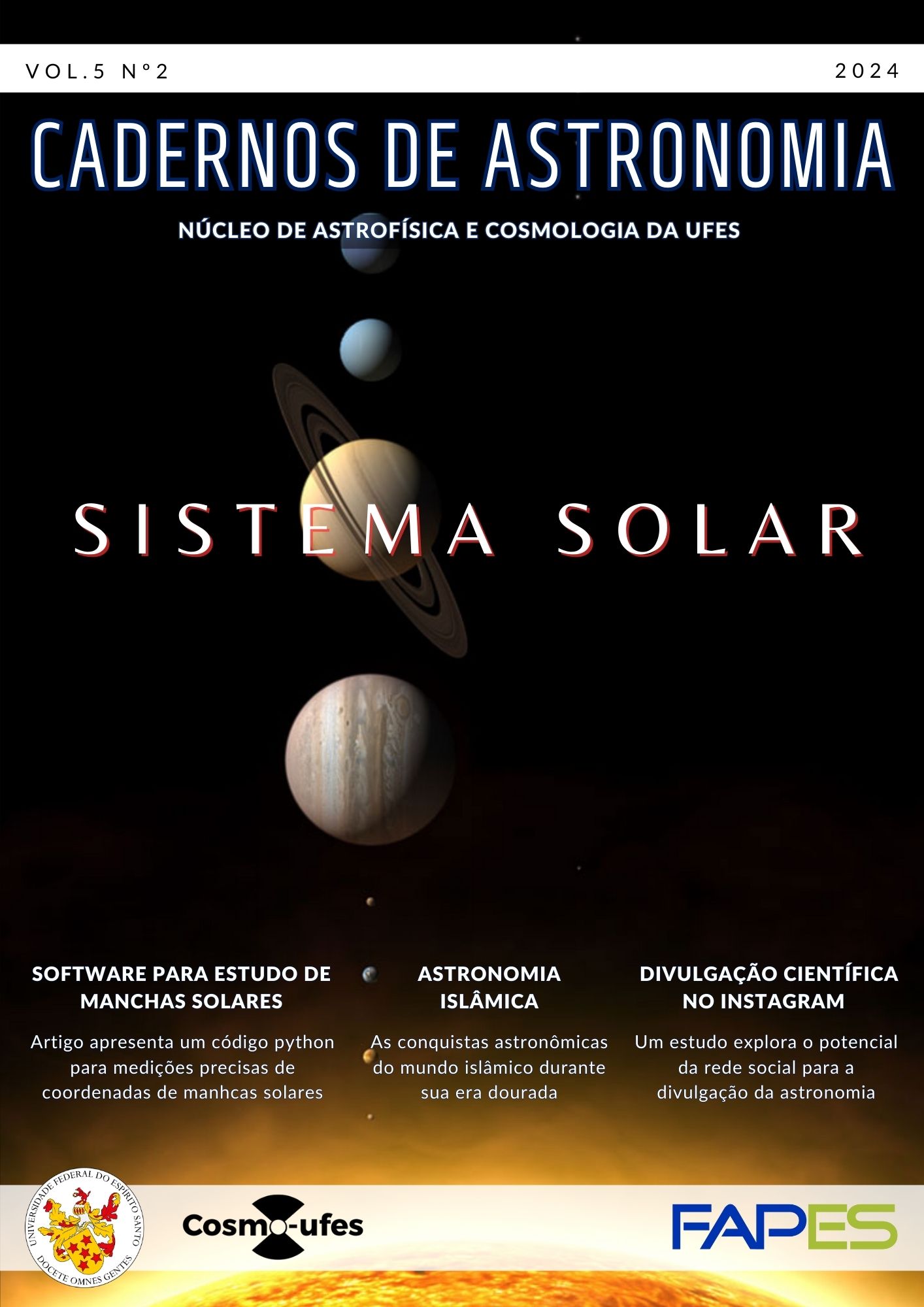Alineación automática de imágenes del disco solar y determinación precisa de coordenadas heliográficas Análisis de manchas solares con PySDIA.
DOI:
https://doi.org/10.47456/Cad.Astro.v5n2.44352Palabras clave:
telescópio de pequena abertura, manchas solares, coordenadas heliográficas, PySDIAResumen
Este trabajo presenta PySDIA (Python Solar Disc Image Alignment), un código Python automatizado para la alineación de imágenes y la corrección rotacional de imágenes de discos solares capturadas con telescopios de pequeña apertura. Hemos aplicado PySDIA a un conjunto de 101 imágenes obtenidas por nosotros mismos que abarcan del 8 de noviembre de 2022 al 4 de diciembre de 2023, para caracterizar y extraer coordenadas heliográficas de 250 manchas solares. Para validar nuestros resultados, comparamos nuestros datos con mediciones de SDO extraídas con el software HelioViewer v2.2. PySDIA alineó y giró efectivamente nuestras imágenes, logrando una excelente correlación entre nuestras coordenadas de manchas solares y las de SDO. Nuestros resultados demuestran que se pueden obtener mediciones precisas de las coordenadas de las manchas solares a lo largo del tiempo utilizando equipos fácilmente disponibles, lo que permite realizar contribuciones independientes a los registros y estudios de las manchas solares.
Descargas
Citas
X. Zhentao, Solar observations in ancient China and solar variability, Philosophical Transactions of the Royal Society of London. Series A, Mathematical and Physical Sciences 330(1615), 513 (1990).
J. M. Vaquero e M. Vázquez, The Sun recorded through history, vol. 361 (Springer Science & Business Media, 2009).
D. V. Hoyt e K. H. Schatten, The role of the sun in climate change (Oxford University Press on Demand, 1997).
H. Schwabe, Sonnenbeobachtungen im jahre 1843. von herrn hofrath schwabe in dessau, Astronomische Nachrichten 21, 233 (1844).
R. C. Carrington, Observations of the spots on the Sun: from November 9, 1853, to March 24, 1861, made at Redhill (Williams and Norgate, 1863).
J. L. Jenkins, The Sun and How to Observe It (Springer, 2009).
J. Wilkinson, New Eyes on the Sun: A Guide to Satellite Images and Amateur Observation (Springer, 2012).
L. Macdonald, How to observe the Sun safely (Springer Science & Business Media, 2012).
E. W. Maunder, Note on the distribution of sun-spots in heliographic latitude, 18741902, Monthly Notices of the Royal Astronomical Society, Vol. 64, p. 747-761 64, 747 (1904).
R. Arlt, The sunspot observations by Samuel Heinrich Schwabe, Astronomische Nachrichten 332(8), 805 (2011).
D. H. Hathaway, The Solar Cycle, Living Reviews in Solar Physics 12(1), 1 (2015).
S. Mandal et al., Kodaikanal digitized whitelight data archive (1921–2011): Analysis of various solar cycle features, Astronomy & Astrophysics 601, A106 (2017).
L. van Driel-Gesztelyi e M. J. Owens, Solar Cycle, Oxford Research Encyclopedia Of Physics. (2020).
J. Curto, M. Blanca e E. Martínez, Automatic sunspots detection on full-disk solar images using mathematical morphology, Solar Physics 250, 411 (2008).
T. Barreto e G. Almeida, Astrofotografia: técnicas e aplicações, Scientia Plena 5(11) (2009). Disponível em https://scientiaplena.org.br/sp/article/view/737, acesso em ago. 2024.
G. Bradski, The OpenCV Library, Dr. Dobb’s Journal of Software Tools (2000).
D. Ratledge, Digital Astrophotography: The State of the Art (Springer Science & Business Media, 2006).
A. M. Price-Whelan et al., The Astropy Project: Building an open-science project and status of the v2. 0 core package, The Astronomical Journal 156(3), 123 (2018).
The SunPy Community et al., The SunPy Project: Open Source Development and Status of the Version 1.0 Core Package, The Astrophysical Journal 890, 68 (2020).
J. D. Hunter, Matplotlib: A 2D graphics environment, Computing in Science & Engineering 9(3), 90 (2007).
R. Pucha, K. Hiremath e S. R. Gurumath, Development of a code to analyze the solar white-light images from the Kodaikanal observatory: Detection of sunspots, computation of heliographic coordinates and area, Journal of Astrophysics and Astronomy 37, 1 (2016).
P. Meadows, Helio Viewer v2.2 User Guide (2023). Disponível em https://www.petermeadows.com/html/software.html, acesso em ago. 2024.
M. E. G. Martins e J. Rodrigues, Coeficiente de correlação amostral, Revista de Ciência Elementar 2(2), 34 (2014).
M. R. Spiegel, Estatística (Makron, São Paulo, 1993), 3ª ed.
Descargas
Publicado
Cómo citar
Número
Sección
Licencia
Derechos de autor 2024 Cicero Dário Grangeiro, Tharcísyo Sá e Sousa Duarte, Jefferson Soares da Costa, Hugo Rodrigues Coelho

Esta obra está bajo una licencia internacional Creative Commons Atribución 4.0.






